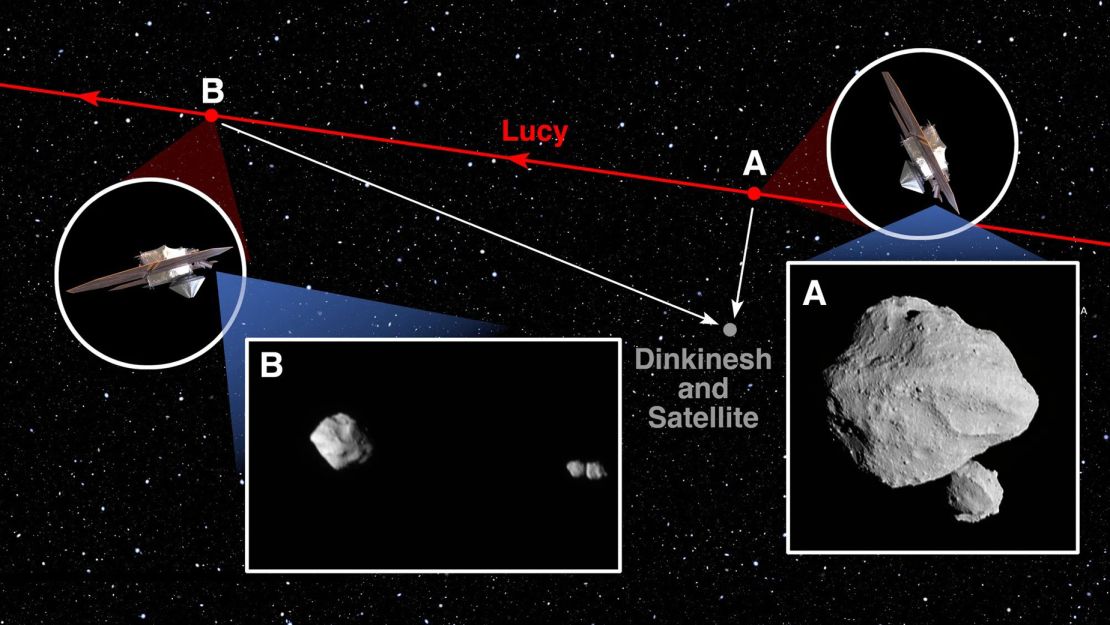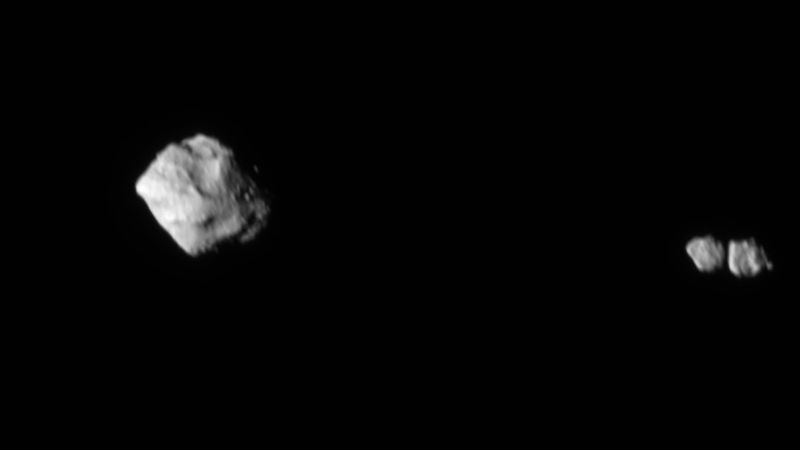Join CNN’s Surprise Concept science e-newsletter. Explore the universe with news on fascinating discoveries, scientific advancements and more.
CNN
—
Dinkinesh, a small asteroid that NASA’s Lucy mission visited final week, continues to shock.
Lucy swung by the house rock, positioned in the primary asteroid belt between Mars and Jupiter, on November 1 as a part of a check of the spacecraft’s tools earlier than tackling the mission’s main aim: surveying the swarms of Trojan asteroids round Jupiter. The flyby of Dinkinesh, which suggests “marvelous” within the Amharic language of Ethiopia, wasn’t even added to Lucy’s itinerary till January.
However the first views captured by Lucy’s devices confirmed there was extra to the shadowy asteroid than anticipated. At first, pictures recommended that the space rock was part of a binary pair, with a smaller asteroid orbiting Dinkinesh.

Nevertheless, further pictures taken by the spacecraft simply after the flyby’s closest strategy have now revealed that the smaller asteroid is definitely a contact binary — two smaller house rocks that contact one another.
Lucy got here inside 265 miles (about 425 kilometers) of the asteroid’s floor throughout its closest strategy, which is when the primary pictures have been taken. The second batch of pictures revealing the contact binary, shared by NASA on Tuesday, have been taken six minutes later from 1,010 miles (about 1,630 kilometers) away.
“Contact binaries appear to be pretty widespread within the photo voltaic system,” stated John Spencer, Lucy deputy undertaking scientist on the Southwest Analysis Institute, in an announcement.
“We haven’t seen many up-close, and we’ve by no means seen one orbiting one other asteroid.
We’d been puzzling over odd variations in Dinkinesh’s brightness that we noticed on strategy, which gave us a touch that Dinkinesh may need a moon of some type, however we by no means suspected something so weird!”
The shut strategy was primarily designed to assist the Lucy spacecraft check its terminal monitoring system, which permits the spacecraft to find the house rock autonomously and preserve it inside view whereas flying by at 10,000 miles per hour (4.5 kilometers per second). The system surpassed expectations, which allowed astronomers to make the invention of Dinkinesh’s surprising companion.

“It’s puzzling, to say the least,” stated Hal Levison, principal investigator for Lucy on the Southwest Analysis Institute, in an announcement. “I might have by no means anticipated a system that appears like this. Specifically, I don’t perceive why the 2 elements of the satellite tv for pc have comparable sizes. That is going to be enjoyable for the scientific group to determine.”
Knowledge from the flyby continues to be transmitting from the spacecraft to the mission staff.
“It’s really marvelous when nature surprises us with a brand new puzzle,” stated Tom Statler, Lucy program scientist at NASA, in an announcement. “Nice science pushes us to ask questions that we by no means knew we would have liked to ask.”
Lucy’s subsequent shut encounter will likely be with one other primary belt asteroid known as Donaldjohanson in 2025. After which, the spacecraft will set off to see the Trojans.
The Trojan asteroids, which borrow their identify from Greek mythology, orbit the solar in two swarms — one which’s forward of Jupiter, the biggest planet in our photo voltaic system, and a second one which lags behind it. Too distant to be seen intimately with telescopes, the asteroids will get their close-up when Lucy reaches the Trojans in 2027.
The mission borrows its identify from the Lucy fossil, the stays of an historic human ancestor found in Ethiopia in 1974. The skeleton has helped researchers piece collectively points of human evolution, and NASA Lucy staff members hope their mission will obtain an analogous feat concerning the historical past of our photo voltaic system.
The asteroids are like fossils themselves, representing the leftover materials hanging round after the formation of big planets in our photo voltaic system, together with Jupiter, Saturn, Uranus and Neptune.

